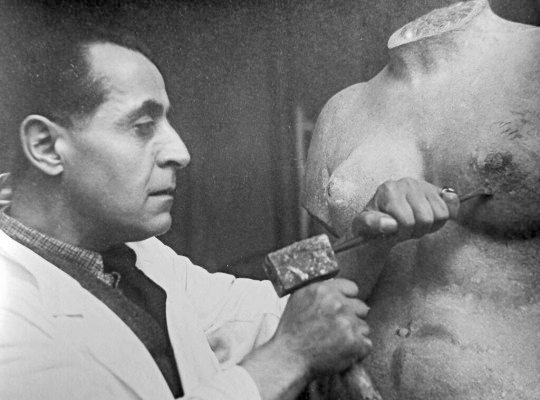HAGOP GURDJIAN (1881–1948)
Salome, holding the head of John the Baptist, 1926
HAGOP GURDJIAN (1881–1948)
Salome, holding the head of John the Baptist, 1926
Painted terracotta, signed and dated on the terrace.
An identical bronze piece is in the National Gallery in Yerevan, Armenia.
According to an episode in the New Testament, the Governor of Galilee, Herod, was dazzled by the charm of his beautiful daughter, Salome, when she danced before him. He was conquered, and he promised to fulfil her every desire. Urged on by her mother, Herod’s sister-in-law, who he was in love with, Salome demanded the head of the prophet John the Baptist, who had criticized the customs of the royal family in his sermons. Herod brought him his head on a plate, and Salome gave it to her mother.
This episode has inspired art and literature for centuries, especially the symbolists and romantics of the 19th century. Heinrich Heine, Gustave Flaubert, Jules Massenet, Oscar Wilde and many others were inspired by this ambiguous character.
Hagop Gurdjian’s Salome masterfully illustrates this cold sensuality, in a representation typical of the 20th century “Art Deco” style.

An Armenian sculptor, born in 1881 in Shushi, a town in what is now Nagorno-Karabakh, and died in Paris in 1948. He came to France in 1907 and studied at the Académie Julian until 1910 and also in Rodin’s studio. He produced many portraits, including those of Maxim Gorky, Sergei Rachmaninoff and the famous Armenian writers, Arshag Chobanian and Shirvanzade.
A participant in the Russian revolution in Moscow, he was asked by Lenin, whom he had met in Paris in 1911, to design a monument to the glory of Karl Marx; during that period he also made portraits of many revolutionaries.
He returned to Paris permanently in 1921.
Throughout his career he took interest in legendary female figures (Leda, Diana, Cleopatra and Salome), and was also an excellent animal sculptor.
In 1945, he exhibited a bust of Kapekine Hovsepian at the Salon des Artistes Libres Arméniens [Exhibition of Free Armenian Artists] in Paris.
Frédéric Fringhian




